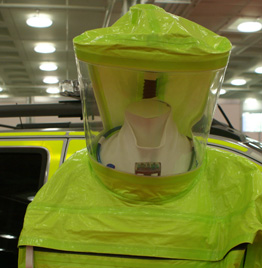Some of the speakers at the Counter Terror Expo 2013.
In the aftermath of a catastrophe, people have to improvise. Hence a three-year project, Resilient Futures, by universities, as described by Dr Julia Pearce of Kings College London. Geographers, engineers and social psychologists among others have looked at the impacts of malicious of natural ‘hazard events’. The project began with some focus groups looking at simulations in the fictitious county of Bagtonshire. Groups watched video clips describing a scenario, such as a 24-hour flood, where the flood defences have held but eventually burst; and when the waters began to recede, a terrorist bomb hit a power plant. Finally, the focus groups discussed what would happen three weeks later. The groups expected the public to be disoriented and probably panicky as a result of the flood, and would need to be reassured and told not to panic; but to evacuate in an orderly manner. There might be a risk of public under-response, taking the example of Americans in the recent Hurricane Sandy who did not think the hurricane would be as it was, and sought to ride it out; likewise in York, homes have flooded yet people did not move out beforehand. As Dr Pearce added, sometimes, people cannot move. Under-response to a catastrophe, she suggested, might be as much of a problem as over-response. Despite possible panic, she suggested that citizens and front-line workers respond with resilience in a crisis. Now the researchers are working to refine their computer map-based imaginary worlds. The project is running an invitation-only event on May 31 at the Royal Society in London. Visit r-futures.ecs.soton.ac.uk.
Some intriguing insights into the mind of Oslo mass-murderer Anders Breivik were offered by Cato Hemmingby of the Norwegian Police University College. That he was one man meant practical constraints on what he could do; but was good for operational security. Breivik before his attack was security conscious and was for example careful about using his computer; but his field reconnaissance was described by Hemmingby as ‘superficial’. Breivik dropped an idea of wearing body armour for better mobility without it. He had prepared an ipod of music to listen to but decided against it so that he could hear better and not be jumped from behind. What might be of interest to designers of safe rooms, Breivik, while on the island where he shot youths, reportedly did not enter some buildings in case of attack. To sum up Breivik, a solo terrorist, overcame the usual psychological constraints against killing; that said, he did choose not to shoot some people.
Some security is better than none, suggested Chris Stevens, formerly of the Home Office, now advising Network Rail and TOCs (train operating companies) as technical security director at SIDOS UK.
You can mitigate terrorism, he suggested, speaking of increased sight lines, designing out voids and places someone could conceal themselves or objects. Lighting should be compatible with CCTV (because it often is not, and instead is excessive, inadequate, or in the face of the camera). He argued that there is real potential for reduced insurance premiums. Straight after a terrorist incident you have an opportunity to go to finance people to say you need to do xyz. A year on, and people’s memories are short; and you have to go back to arguing why it’s necessary to install. He stressed early engagement saves on costs. Security should be included as part of the design as early as possible, rather than added on later. Aesthetics and security are not mutually exclusive, he said. “The security adviser if possible should sit as part of the development team rather than an outsider, so that they are able to respond throughout the design and delivery stages. It’s easy to over-specify without considering costs, he suggested. It’s important to be realistic and proportionate because avoiding risk is almost impossible to achieve. Make an unequivocal line between public and private space, he said, so that you do not give people the excuse to say they did not know they should be in an area. That laminated glass can reduce crime as well as have an impact on terrorism becomes an easier sell. On that point, he asked that businesses look at other sorts of crime, such as ram raids on shops or vaults. He gave a case of thieves driving through the entrance glass of a hospital to drag away an ATM from a wall inside.










